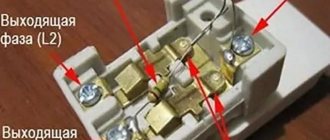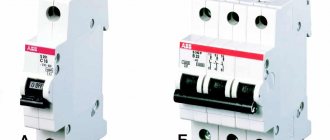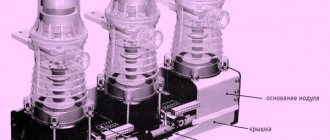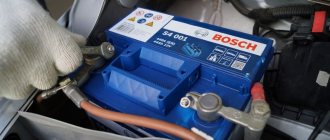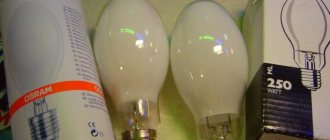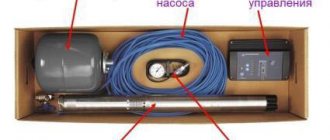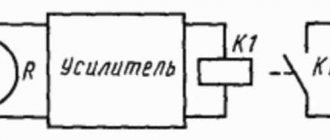The operation of pumps is controlled using various devices, and one of the most common is a water level float switch. It can simultaneously perform the task of a water level sensor and be an actuator for controlling the pump. Floats for the pump are placed in containers.
One tank can accommodate several such switches, and they can solve different problems:
- Monitor the operation of the main pump.
- Serve as an overflow sensor.
- Ensure the operation of the auxiliary pump.
- Serve as an emergency level sensor.
With the help of such devices, the pumping apparatus is protected from the “dry running” mode. When filling different tanks, this element protects them from overflowing. Float switches for pumps come in light and heavy sizes. The former are more often used in drainage and water supply systems; the second - in drainage, rain and fecal wastewater. In stores, devices are sold with a cable length of 2, 3, 5, 10 m.
Device design
The floating plastic switch housing contains an electrical switch and a lever that moves the switch contacts. There is also a steel ball that adjusts the position of the lever when the float position changes. of three wires is connected to the switch , the first of which is common, and the rest are connected to the normally closed and open contact of the device.
The circuit is completed by the black and blue wires when the float is in the down position. When you move it to the top position, the brown and black wires become the closing contacts. The wire that does not provide connection to the device must be insulated.
It is important that the supply cable has moisture-proof properties; the plastic box must be sealed. The cable outlet is sealed using a mechanical seal, and it also has a special device that eliminates mechanical stress in the cable. The insulated cable gland cavity contains a polymer resin that prevents water from entering.
The chemical properties and heat resistance of the housing and cable sheath, made using thermoplastic rubber, determine the switch’s ability to withstand interaction with the following aggressive substances:
- uric acid;
- alcohols;
- fecal water;
- gasoline;
- other things.
Due to the lack of pores on plastic cases, dirt appears on them. Because of this, sand, paper and other solids slide off, and the float remains buoyant.
Characteristics of the water level control sensor:
- Maximum switching current, A;
- Mains voltage, V - 220±10%;
- 10A - for active loads (starters, lamps, switches, heating elements, etc.);
- 8A - for reactive load (compressors, pumps, fans, etc.);
- Operating temperature range: 0−60°C;
- Protection: IP 68.
Rating of switches of the middle valuable segment
WATTS IGD
A high-quality product from a German manufacturer that can function for ten years without requiring complex maintenance. Supplied in a plastic case that is well sealed and does not allow water and dust to pass through.
The maximum operating temperature is 60 degrees. Thanks to the high-quality material, the product can be used even when pumping gasoline, without the outer layer being destroyed.
The average price is 1,900 rubles.
float switch ]WATTS IGD
Advantages:
- Durable housing;
- Durability;
- Easy to use;
- Efficiency;
- Switching angle – 95o.
Flaws:
- Not found.
Marco AS2
A good product made in Italy, which has a high service life and reliability. The main advantage of the device is the ability to control a small water level (from 20 to 50 mm). This is not found in every design, which makes the product unique.
The body is smooth and has no irregularities, which allows it to be used in any system. The outer part is made of impact-resistant plastic, which is also a good solution. Operating current – 10 A.
Sold at price: 1,900 rubles.
float switch Marco AS2
Advantages:
- Efficiency;
- Durability;
- Appearance;
- Strength indicators;
- Able to monitor low water levels;
- Wide range of applications.
Flaws:
- Not found.
Wilo WA 65
A quality product with a 5 meter cable that is suitable for installation in a variety of tanks. The insulation is performed at a high level, which prevents accidental breakage and depressurization. The body is made of durable material that can function at 55-60 degrees. The kit includes a special weight.
The average price is 2,000 rubles.
float switch Wilo WA 65
Advantages:
- Length of cable;
- Universal application;
- Convenience;
- Easy to clean;
- Efficiency.
Flaws:
- Not found.
Advantages of the device
Among the advantages of a float switch, the first thing to highlight is that this device can serve as a regular sensor for determining the water level in a tank. It performs this task regardless of the purpose of using the container and its volume. This device will make the operation of the pump more convenient and simplify control of the functions of domestic and industrial water supply systems. Sometimes it can be used to successfully drain fluid.
The switch can be an element as part of the equipment during the construction of sewer communications. Simplicity and efficiency have ensured its widespread use in a variety of systems where it is necessary to control water levels. The ability to protect pumping systems in dry running mode is not the only advantage of the devices. With their help, you can prevent situations where water overflows in containers.
Float switch installation
Devices can be installed in different ways. Before installation, you should make sure that the rated current required to operate the pump is less than the maximum permissible value given in the technical characteristics of this type of float. Among the known installation methods, the simplest is to place it in a tank, which involves the use of a device with a cable and a special sinker supplied with the device.
With this installation, the sinker is fixed on the cable, and then the length of the free-running arm is experimentally calculated. Using a latch, the sinker is secured to the cable, and then the cable is firmly fixed to the outside of the tank. The switch is then connected to the pump, and the device can be used for its intended purpose.
The float mounting option, which involves the use of a supply cable, can only be used when there is no risk of the main device getting caught or hanging in the tank itself and when there is only one float in it.
Sometimes several floats are installed. They are mounted on a rod, the role of which is often played by fragments of a plastic pipe, which is firmly fixed in the tank. Then floats are installed on the pipe, which must be correctly positioned, adjusted, and spaced along the length of the rod so as not to create difficulties for work.
The cables coming from the floats are connected to the rod using clamps. When choosing the number of float switches, pay attention to the number of pumps or the type and number of safety devices and control panels. Sometimes the problem of ensuring the operation of switches can be solved by using several rods. When determining installation schemes, their quantities and locations, each time take into account the features of the place of their installation or check with the project.
Video description
Float switch - brief operating principle, connection diagram
Method of connecting and setting up floats
Manufacturers, as a rule, provide different methods for both mounting and connecting float switches to the pump motor. But in any case, before installing such equipment, you need to make sure that the current that the pump consumes during operation is less than what is indicated as the maximum allowable for the operation of the float. The easiest way to install a float switch is to use it in a special tank, for which a cable and sinker with a chain are supplied.
1) connection diagram for pumping out the container; 2) connection diagram for pumping the tank Source m-strana.ru
To install the float you will need:
- Fix the sinker with a leash on the body and calculate the free movement of the switch when changing modes. This means that you need to adjust the length of the leash so that when tensioned, the float tilts 70° and the contact terminals switch to on mode.
- Secure the cable to the outside of the tank so that it does not lift or completely pull out the float.
After installing and connecting the float, you should check its functionality - start the engine and make sure that everything is functioning correctly. If you find any failure, then you need to turn off the pump and make sure that the device is installed and connected correctly.
Principle of operation
Depending on the operation scheme of the float switch, the operating principle of the device also changes.
Water supply system, filling and emptying the tank . When the float operates according to this scheme, at the moment of ascent it de-energizes the pump that supplies water to the tank. When the float is on the surface, it gives a signal to turn on the automatic water supply station. The station can only be turned off when the device is immersed to the bottom when the container is empty.
Sewage system . The fecal pumping equipment is switched on when the main control device is raised. The pumping unit turns on when it sinks to the bottom. One float is capable of servicing two pumps at the same time: the first can supply water to the container if the float is in its lower position, the second pump is inactive at this time. When the float is at the top, the second pump is turned on, pumping out water. During this time the feed pump is inactive. This scheme is quite effective, as it eliminates problems with the regular delivery of water when filling the container.
Self-manufacturing of the sensor
Suppose the task is to automate the use of a “Malysh” type pump to provide water to a summer house or country house. As a rule, water is pumped into a storage tank, and it is necessary to ensure timely, automatic shutdown of the pump when the tank is sufficiently filled. There is no need to install complex and expensive sensors for this. You can make a device based on a reed switch that will perfectly perform the task with your own hands. Let's call this device: an electric float valve for the water level in a tank based on a reed switch.
Reed switch
A reed switch is a switch that is the main performing part in the device of a reed switch water level sensor for controlling a pump. It looks like a small sealed glass container with a vacuum or inert gas inside. Inside there is a closed or open contact group, in other words, two closed or open contacts made of ferromagnetic material with a gold or silver top coating. When exposed to a magnetic field, the contacts of the part are magnetized and repel each other, opening the circuit in which they are connected, stopping its operation, or, conversely, they close and turn on the circuit. Reed switches are divided into two types:
- Reed switch with normally closed contacts.
- Reed switch with normally open contacts.
The environment inside the glass bulb prevents oxidation of contacts and the formation of sparks when shorted.
Sensor device based on a reed switch
To manufacture the device, you will need a 220-volt magnetic coil starter and a pair of reed switches, one of which is closed in the normal state, and the second is open. And you will also need a float for the water tank, which is made of foam plastic, a rod, a tube and three wires of small cross-section and thickness.
The operation of the device is simple and, most importantly, safe. The operating principle is as follows:
- In the process of collecting liquid, the float with a magnet, having reached the maximum level of the reed switch, which is in a closed state, opens under the influence of the magnetic field, commutating the power triggering coil, which turns off the pump.
- As the water from the reservoir decreases, the float lowers and when it reaches the lower reed switch, which is triggered by a short circuit under the influence of a magnetic field, the starting coil is switched to start the pump.
- A sensor made according to this principle can operate for many years without complaints, unlike electronic control systems for monitoring the filling of containers. Making a float water level sensor with your own hands is not difficult, and it does not require any special knowledge in the field of electrical engineering.
Scheme for controlling water pumping by a drainage pump
Based on the principle of vertical operation of the float mechanism, it is possible to propose a sensor connection diagram for switching the drain pump start relay with an additional 12 volt power supply.
It is worth noting that reed switches are not capable of handling high currents and cannot turn the pump on or off directly. Therefore, they are used in low voltage circuits to switch high-power relays to start or stop a pump. When the level is high, liquid is pumped out until the minimum set level is reached. The operating principle is as follows:
- When the liquid in the container rises to the upper level, the float with a magnet closes the upper reed switch SV 1, and current begins to flow to the relay coil P1. The contacts close in parallel with the connected reed switch, which puts the relay into a self-capturing state. This function does not allow the coil supply voltage to be switched off when the reed switch SV 1 is opened. This is achieved by connecting the relay load and its coil in one circuit.
- The power coil of relay P2 in the electric pump power circuit is switched on and liquid pumping begins.
- When the liquid level decreases, the float with a magnet reaches the lower reed switch SV 2, closing its contacts. A positive voltage potential begins to be supplied to the relay coil P1 from the other side as well. This leads to the removal of the self-capture function and the relay being turned off, which switches off the power coil P2, which provides power to the electric pump.
- By swapping the reed switches SV 1 and SV 2, the sensor will turn off the pump when the container is filled to the set level and turn it on when the liquid level drops.
Operation, repair, maintenance
Compliance with the rules for operating floats will ensure their long-term operation. When the float is included in the water supply and sanitation system, you should not waste time on its maintenance. If the device controls the operation of sewer or fecal pits, it is recommended to clean the float and pump from contaminants at least once a month with a stream of water supplied under pressure. This will prevent the float from sticking or sticking to the discharge pipe or pump. A broken float switch is replaced, and the replacement is carried out by specialists from service centers.
When it is necessary to provide drinking water or remove contaminated wastewater, special devices are used together with pumps, in particular, a float switch. Since the device prevents dry-running, the service life of the pump is increased. A lot of energy is also saved, because, thanks to the float switch, the pump is activated only when necessary.
Connecting and repairing a float for a pump
Connecting a float switch to systems that use submersible pumps to pump out water is no different from connecting to drainage and sewer systems. Connection to the pump is made as follows:
- the sinker clings to the wire and the length from the sinker to the device is adjusted experimentally;
- the cable should be securely fixed to avoid it touching pipes and other devices inside the container;
- if the device is two-phase, then two (or more) units should be used - one for pumping water into the container, the other for pumping it out. In wells and self-filling tanks, one two-phase can be installed;
- connecting wiring to the pump.
When connecting to the pump, moisture-proof terminals are used. The wiring and connection points on the pump are marked; difficulties may arise only with connecting a two-phase float to a three-phase pump. Two important points when choosing devices:
- The same current consumption in amperes for the pump and the float (or even slightly less for the latter).
- The same number of connection phases.
The power of the pump should also be taken into account.
The device installed in the system can be connected to the float in two ways:
- if its power is less than 1.2 kilowatts, then the connection is made directly through the network cable;
- if the power is higher than 1.2 kilowatts, in this case the connection occurs through an electromagnetic relay or other switching link.


